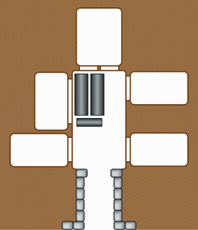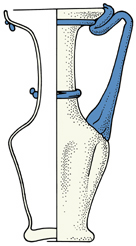Glassware in Funerary Ritual

Marble funerary chest
1st century A.D.

Tomb 295 at Bet Shean, in Israel
3rd to 7th centuries A.D.
I should like to have all kinds of fruit growing round my ashes, and plenty of vines. It is quite wrong for a man to decorate his house while he is alive, and not trouble about the house where he must make a longer stay." (Petronius, Satyricon 71)
Most of what we know about Roman glassware comes from interpretation of its use as a grave good; inevitably so, perhaps, since urban areas usually evolve by the destruction or modification of earlier structures, so committing all kinds of domestic material to landfill and trash pits. Cemeteries that, out of respect for the deceased, usually were set apart from the homes and streets of the living, were intruded upon only rarely.
The Romans believed that a tomb was the spiritual counterpart for a house. Many funerary chests were decorated with doors through which the deceased's spirit could pass, and with a roof that gave shelter against the elements. Inside the chest there would be an urn of pottery or glass that contained the deceased's cremated remains, and a heap of offerings that would make the Afterlife comfortable. There would be platters and bowls piled high with meats and fruits, and flasks filled with wine. Also, in keeping with proper funerary ritual, there would be several unguentaria containing the most finest perfumed lotions the deceased's relatives could afford.
In the eastern provinces, inhumation rather than cremation was the norm. Still, the notion of a tomb being a sturdy shelter for the deceased’s remains held sway there as well. The tomb complex illustrated here, from the northern cemetery at Bet Shean, in Israel, is typical. The entrance porch was roofed over just by two old sarcophagus lids; the central chamber was rough-hewn, and at some point, a pit had been dug in its floor to make space for three unlidded sarcophagi. Glassware scattered in the entrance way indicates that, to avoid the expense of digging out new rooms, older graves were cleared away from time to time, to make way for fresh ones.
The best preserved vessels were found in the second grave on the left, where the interment dates to the mid-4th century A.D. With the exception of one pottery oil lamp, a bronze bracelet and a bronze bell, all the artifacts in that grave were of glass, all of which (apart from one wine jug) was associated with cosmetics, either for storage or preparation.

Ointment pot
[32-15-80]

Cylindrical flask
[32-15-85]

Juglet
[32-15-66]

Loop-handled bottle
[32-15-59]

Galena flask
[32-15-68]
